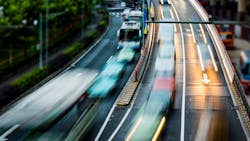To make U.S. mobility more sustainable, improve access to public transit
As summer and popular traveling months wrap up, it’s a good time to look at the U.S. track record on public infrastructure and explore how organizations can come together to make it more sustainable. In the U.S., multiple trends are currently colliding, which create a unique opportunity to rethink how to make transportation in our nation more accessible, usable and environmentally friendly over the long-term.
In November 2021, the Biden Administration signed into law the $1 trillion Infrastructure Investment and Jobs Act, which provides unprecedented funds to improve public transportation. Among the allocations are $110 billion in new monies for roads, bridges and major projects; $66 billion for passenger and freight rail; $39 billion for public transit; $25 billion for airports; $17 billion for port infrastructure; $11 billion for transportation safety; and $7.5 billion each for electric vehicles and zero- and low-emission buses and ferries.
While an important start, it obviously won’t be enough. The American Society of Civil Engineers (ASCE), which issues a report on the nation’s public infrastructure every four years, rated the country’s capabilities as a C- in 2021—up from a D+ in 2017. Public infrastructure needs $2.59 trillion over the next 10 years to create a system that’s “fit for the future,” says ASCE.
Further, it’s clear that the funding allocations still favor roads, which are primarily used by single-passenger cars and trucks over other forms of shared public transportation. That’s likely an acknowledgement that 43 percent of roads are in poor shape, but it still doesn’t move the country forward to achieving its climate change goals.
The role of transportation in meeting national sustainability goals
Research has shown that global infrastructure construction and operations cause 79 percent of all greenhouse gas (GHG) emissions with transportation representing 16 percent of these emissions. In the U.S., an industrial, modern society, transportation contributes even more, representing 29 percent of the country’s GHG emissions. This statistic alone should create even more impetus to act, especially now that the time to effect major change with the country’s climate response is growing short.
Single-occupancy vehicles may not be sustainable, but public transportation is, moving scores of residents and commuters simultaneously to their destinations around the clock. In 2018, public transport in the U.S. saved 63 million metric tons of carbon dioxide emissions. Communities with buses, rail or subways avoided 148 billion miles of personal vehicle travel in 2018, or five percent of the total three trillion miles consumers traveled by car that year. And they accomplished this goal when the average transit vehicle carried just 12 passengers. Imagine the impact if each vehicle was full. Unfortunately, the COVID-19 crisis has decreased ridership further, causing organizations to scale back services. However, as inflation grows and the prospect of a recession beckons, many consumers may give public transit a second look, driving usage of these important services.
Further, robust public transportation creates equity, opening new opportunities to disadvantaged communities. Public transportation is disproportionately used by women, young adults, Black adults and low-income workers, who may also struggle with last-mile connections from home to school and work. Providing mobility access and options to these vulnerable populations is an important part of making public transportation truly sustainable.
New mobility models can help spur user adoption
Improving consumer adoption of U.S. public transportation isn’t simply a case of offering services. If so, commuters and residents would already use them more heavily than they do now. No, spurring public transportation usage involves a complex mix of modernizing and extending the rail, bus and ferry networks that currently exist. This process includes providing capacity in the right places, solving for first-mile and last-mile gaps that can impede usage and adjusting services to meet changing community needs. It also means ensuring stops are truly safe and accessible by all, including those with personal mobility concerns. Further, transportation agencies need to make it easier for consumers to use these services. Consumers want to easily plan their journey, use multiple forms of transportation to reach their destinations and pay for everything in one place.
Federal and state transportation agencies can improve accessibility and drive usage of services by adopting mobility on demand (MOD) and Mobility-as-a-Service (MaaS) models. MOD positions transportation as a commodity with different travel modes having unique values based on a journey’s cost, total time, wait time, number of connections, convenience and other variables. As a result, consumers can use MOD information to plan the most efficient and cost-effective route to their destination. MaaS solutions package and integrate different transportation services, such as rail, bus, car, bike and ride sharing, enabling consumers to plan journeys easily and use multiple transportation methods as they travel.
Private companies can aid transportation agencies all over the world in accomplishing these goals through partnerships and the utilization of MOD and MaaS concepts to provide users with a smart travel platform they can use to plan their journeys, seamlessly integrating multiple forms of transportation into a single trip and paying with one transaction. Transportation authorities benefit by delivering an exceptional experience to riders, integrating payment options, driving usage of all services and using analytics to plan new enhancements. Similarly, businesses can assist cities to integrate multimodal transportation with congestion management. By doing so, transportation authorities can address a common complaint of riders (crowded buses, railcars and subways), ensure a more seamless flow of passengers across all services and increase their ROI on investments.
Conclusion
Improving public transportation equity, access and usage is a goal the U.S. should strive for as it meets real needs and helps address the climate change threat. Fortunately, MOD and MaaS tools already exist today that link riders, services and transportation agencies in a virtuous circle to make transportation truly sustainable. As a result, they will create new opportunities for consumers and organizations today and for generations to come.
Anna Allwright is a self-confessed “transport geek” with nearly a decade of industry experience spanning strategy, marketing, government and public affairs.
About the Author

Anna Allwright
Strategy Specialist, Cubic Transportation Systems
Anna Allwright is a self-confessed “transport geek” with nearly a decade of industry experience spanning strategy, marketing, government and public affairs. As strategy specialist at Cubic Transportation Systems, she helps erode perceptions that public transport isn’t for everyone and build a future mobility network that makes public and active transport the modes of choice for more people.
